Starlit Serendipity: Capturing the Iris Nebula and the Enchanted Birch
While the night’s original intention was to focus on the Iris Nebula, the session unfolded into an unexpectedly delightful experience. My primary goal was to capture this celestial feature using my FSQ106 telescope. As is typical for my astrophotography ventures, I brought along additional cameras, always prepared for the chance to capture other intriguing scenes. With meticulous care, I set up the telescope, fine-tuning its polar alignment and calibrating the software to automate capturing images. Satisfied with the arrangement, I allowed the telescope to operate independently. Seeking a moment of relaxation, I wandered off and soon found myself mesmerized by a scene in a nearby field. There, under the Milky Way, stood a solitary birch tree. Its striking silhouette, set against the enveloping darkness, immediately caught my attention and ignited a spark of inspiration for an unplanned photographic endeavor.
The birch tree’s allure motivated me to set up a time-lapse sequence. Using my Canon 6D paired with a Rokinon 14mm lens, I knew the impact of the camera’s positioning would be pivotal in capturing the essence of the tree. Adjusting the camera took considerable time, as I sought the perfect angle where the tree’s intricate branches would be dramatically framed against the winter’s night sky.
To highlight the tree’s structure, I employed a white headlight, strategically placed to cast an ethereal glow from beneath. This lighting choice created a striking contrast, making the birch tree stand out vividly against the backdrop of the Orion constellation and the winter Milky Way. The combination of the wide-angle lens and the under-lit tree resulted in a captivating scene, almost otherworldly in its appearance.
As the time-lapse camera embarked on its silent task, capturing the slow dance of the stars and constellations, I returned to my telescope. The Iris Nebula, with its dust clouds and distant stars, continued to be the primary objective. In fact I would return several times over the course of the next week to wrap this project up. However, my thoughts frequently drifted to the time-lapse camera, curious about the magic it was recording.
As the hours passed, the chill of the night intensified. I knew that without dew heaters, the lens of the camera might succumb to the cold, risking the formation of ice. This concern lingered in the back of my mind as I focused on the nebula. Eventually fatigue set in, prompting an earlier-than-planned departure. The long drive back through the mountains required alertness, compelling me to pack up while the night was still young.
Upon returning to the time-lapse camera, I found the lens covered in a thin layer of ice. This discovery was both a disappointment and a testament to the unforeseen challenges of night photography.
Later, reviewing the time-lapse footage, I found that the hour or so before the lens iced over had actually captured a remarkable scene. The under-lit birch tree, with its branches reaching towards the sky, stood boldly against the backdrop of moving stars. The constellations of Orion and Taurus could clearly be seen slowly making their way across the night sky. The footage was a unique blend of earthly nature and celestial wonder, a serendipitous creation born from an impromptu decision.
This experience, while not going as initially planned, offered a valuable lesson in adaptability and the beauty of embracing unplanned moments. The contrast between the meticulously planned capture of the Iris Nebula and the spontaneous time-lapse of the birch tree under the stars was a reminder of the diverse joys photography can bring. The night was a perfect example of the technical skills required for astrophotography but also highlighted the importance of adaptability and the joy of unexpected discoveries in the field.
